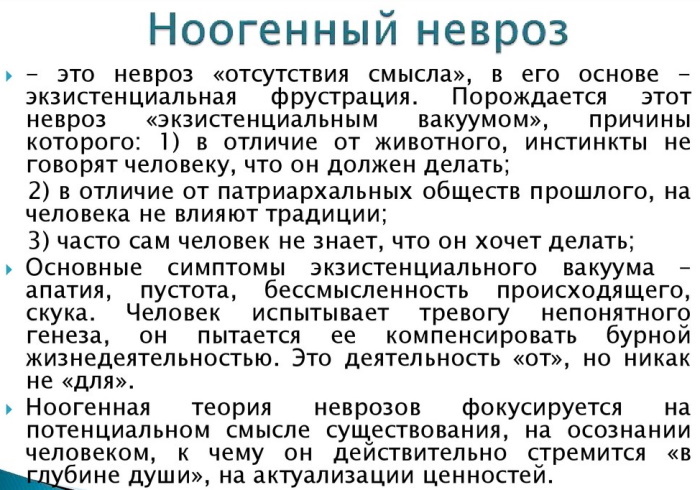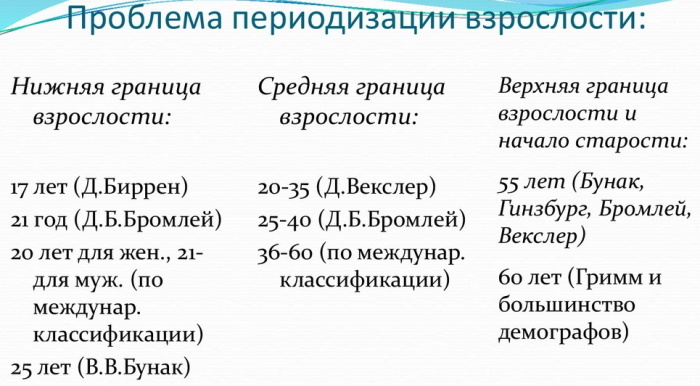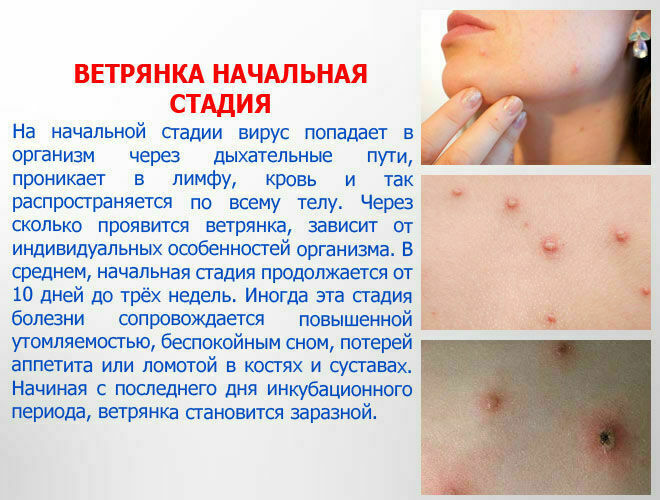Content
- What is vocal cord paresis (laryngeal paralysis)
- Signs and symptoms
- Causes and forms of pathology
- Congenital paresis
- Infection
- Tumors
- Trauma, postoperative period
- Thyroid disease
- Systemic neurological diseases
- Cardiovascular disease
- Diagnostics
- Voice therapy, gymnastics
- Severe attacks of the glottis
- Arrow half-throat
- Abdominal breathing
- Lips and trills of the tongue
- Surgery
- Postoperative outcomes
- Voice therapy after surgery
- Video about paresis of the larynx
Vocal cord paresis occurs suddenly or develops over a long period of time. This disease can be congenital, or it has an acquired nature of origin. The treatment of paresis of the vocal cords is carried out by an otolaryngologist with the participation of doctors of other specialized specialties, depending on the causes of the laryngeal disease.
What is vocal cord paresis (laryngeal paralysis)
Paresis of the vocal cords is a pathological condition of the throat tissue in which there is a complete or partial loss of voice. This disease is accompanied by dysfunction of the peripheral nerve, which is responsible for the mobility of the muscle tissues of the larynx.
The result of a neurological disorder is immobility of the vocal folds, the absence of a closing effect when trying to reproduce sounds or individual words. A person with paresis of the larynx loses the physiological ability to carry out reflex movements, which involve the muscles of the throat. In especially severe cases, not only loss of voice occurs, but breathing becomes difficult, which complicates the further process of treatment.
The table below shows the classification of the pathological condition of the vocal cords:
| Type of disease | Distinctive features |
| Laryngeal paresis | This diagnosis is given to children, adult men and women in whom less than 12 months have passed since the onset of immobility of the ligaments. In this case, there is a favorable prognosis for the reversibility of pathological processes with complete restoration of voice functions. |
| Laryngeal paralysis | Complete paralysis of the throat muscles is a severe complication of a concomitant disease that leads to dysfunction of the vocal cords. A similar diagnosis is made for patients in whom the inactivity of the muscles of the larynx persists for more than 1 year. |
 During the reproduction of even the simplest sounds in the larynx, peripheral nerves, brain centers, muscle tissues and cavities of physiological resonators are involved. In the process of examining patients with signs of paresis or complete paralysis of the vocal cords, doctors take into account all factors that can have a negative impact on their structure, cause a violation mobility.
During the reproduction of even the simplest sounds in the larynx, peripheral nerves, brain centers, muscle tissues and cavities of physiological resonators are involved. In the process of examining patients with signs of paresis or complete paralysis of the vocal cords, doctors take into account all factors that can have a negative impact on their structure, cause a violation mobility.
Signs and symptoms
Paresis of the vocal cords (treatment of the disorder requires an integrated approach) is a pathology that is a consequence of an existing disease.
The following symptoms and main signs of this disease are distinguished:
- mild or severe hoarseness, which occurs gradually, or appears suddenly (it all depends on what causes the paresis);
- dry cough, during which sputum does not separate;
- sore throat;
- changing the tone of the voice with the production of higher or lower sounds;
- rapid fatigue during insignificant vocal load;
- hoarseness of voice;
- breathing problems;
- violation of the swallowing reflex;
- complete loss of voice;
- shortness of breath caused by a spasm of the smooth muscles of the larynx.
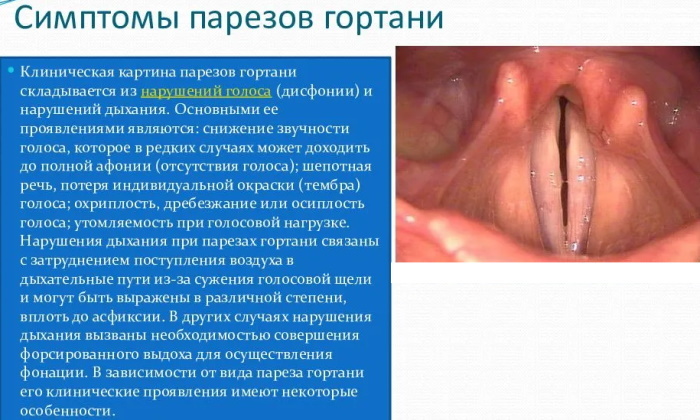
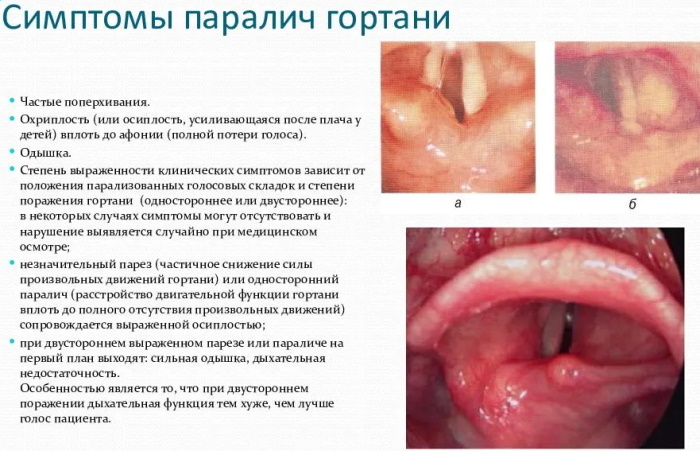
The presence of the above symptoms is a good reason for seeking medical help from an otolaryngologist. In the process of a more detailed diagnosis, the doctor discovers that the patient's vocal cords do not close along the entire length of the larynx. This leads to the fact that a characteristic gap is formed between the muscle tissues in the throat area.
Causes and forms of pathology
The table below describes the forms of laryngeal paresis, depending on the clinical manifestations of this pathology.
| Forms of paralysis of the vocal cords | Characteristics of the disease |
| Partial | Partial paresis is characterized by a mild course of the disease. A person with a similar pathology has a slight hoarseness, sore throat, problems with the reproduction of certain sounds, but the functions of the voice are preserved. |
| Full | Complete paralysis of the vocal cords is considered a severe pathology. In this case, there is an absolute immobilization of the muscular tissues of the throat. The patient loses his voice, has difficulty swallowing, complains of squeezing sensations in the larynx. |
| Unilateral | With unilateral paresis, only a part of the vocal cords is in the affected area. The functions of muscle tissues responsible for speech reproduction are practically preserved. |
| Bilateral | In conditions of bilateral paresis, complete paralysis of the smooth muscles of the larynx occurs. Such conditions arise suddenly under the influence of one or several pathological factors at once. The main danger of bilateral paralysis of the vocal cords is that the patient may die from suffocation. Patients with this form of paresis require urgent surgical treatment. |
| Spicy | The acute form of paralysis is a consequence of progressive diseases of the body that disrupt the functions of the larynx. The development of this pathology may be accompanied by complete or partial dysfunction of the throat muscles. |
| Chronic | Chronic paresis is a consequence of a previously transferred pathology, which led to irreversible changes in the structure of the vocal cords. This disease can be accompanied by periodic exacerbations. |
 There are a large number of reasons, the presence of which contributes to the occurrence of complete or partial paralysis of the larynx with a different form of its development.
There are a large number of reasons, the presence of which contributes to the occurrence of complete or partial paralysis of the larynx with a different form of its development.
Congenital paresis
Vocal cord paralysis may have a congenital etiology. In this case, the painful condition of the larynx occurs due to the hereditary predisposition of the child, or it is a consequence of intrauterine developmental abnormalities.
With congenital paresis, anatomical defects of the vocal cords are found, signs of damage to the nerve fibers responsible for the innervation of the smooth muscles of the throat are observed. The danger of congenital paresis lies in the fact that dysfunctional disorders of this part of the larynx entail other pathologies of the child's mental and physical development.
Infection
Paresis of the vocal cords (treatment of the disease begins immediately after the completion of the diagnosis) can occur under the influence of a focus of chronic infection. Children, adult men and women who have previously had diphtheria, a severe form of the influenza virus, suffer from chronic tonsillitis, tracheitis, risk full or partial paralysis larynx.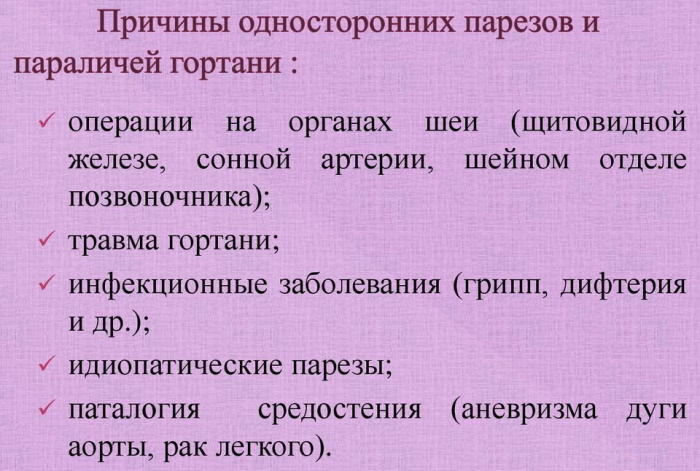
In this case, bacterial and viral microorganisms cause local inflammation of smooth muscles, disrupt the work of peripheral nerves responsible for the expansion and closure of the vocal cords. This pathological cause is characterized by the occurrence of chronic paresis with periodic exacerbations of the disease.
Tumors
Complete or partial paralysis of the vocal cords can occur when a benign or malignant tumor is localized in the larynx region. An extraneous neoplasm compresses the nerve endings responsible for the contraction of the smooth muscles of the throat.
Similar symptoms are found in people with a neck cyst, laryngeal oncology, and esophageal diverticula. Timely removal of the tumor allows you to completely restore the functions of the vocal cords and exclude the factor of concomitant complications.
Trauma, postoperative period
According to medical statistics, most of the complete or partial throat paresis are the consequences of thyroid surgeries. This complication occurs due to the fact that the nerve responsible for the functions of the vocal cords passes in close proximity to the tissues of this organ of the endocrine system.
In the process of surgery, unintentional damage to the peripheral nerve is possible, which entails a violation of the innervation of the ligaments on the right or left side. Patients with this cause of paresis have a quiet and hoarse voice, which immediately wheezes when trying to reproduce loud sounds. Similar effects appear in people who have had tracheal intubation and other laryngeal injuries.
Thyroid disease
Paresis of the vocal cords (treatment of pathology is based on medical and surgical therapy) occurs in people with acute or chronic diseases of the thyroid gland. For example, with tumor neoplasms in this organ. Pathological proliferation of thyroid tissue, accompanied by the appearance of nodules, causes compression of the peripheral nerves. The result of endocrine disease is a violation of the innervation of the smooth muscles of the larynx.
In this case, the patient must have concomitant symptoms in the form of a feeling of a lump in the throat, squeezing of the trachea, shortness of breath. Timely treatment of pathological conditions of the thyroid gland allows you to fully restore the functions of the vocal cords.
Systemic neurological diseases
Neurological disorders are classified as congenital or acquired. This cause of paresis of the vocal cords is diagnosed in people with damage to the structure of the vagus nerve. In this case, the patient has bilateral paralysis of the smooth muscles of the throat.
Neurological pathology can be caused by the influence of the following factors:
- Previous surgery in the neck that resulted in damage to the vagus nerve
- anomalies of intrauterine development of the nervous system;
- the consequences of bacterial or viral damage to peripheral nerves;
- complications after severe traumatic brain injury;
- cerebral stroke;
- the periodic occurrence of ischemic attacks on the centers of the brain, which are responsible for the reflex contraction of the vocal cords;
- inflammation of the lining of the brain;
- autoimmune diseases of the central nervous system;
- age-related neurodegeneration of nerve cells;
- inflammatory damage to the spinal cord.
Neurological causes of paresis of the vocal cords are considered the most dangerous and difficult to treat. In most cases, dysfunctional disorders of the larynx are irreversible.
Cardiovascular disease
There are 2 main diseases of the cardiovascular system in which partial paralysis of the larynx is possible. This is a pathological expansion of the walls of the pulmonary artery, as well as an aortic aneurysm. Both diseases are life-threatening, as they can cause sudden death.
Diagnostics
Paresis of the vocal cords (treatment of the damaged area of the larynx is carried out with the use of antimicrobial agents) is diagnosed by an otolaryngologist using laryngoscopy. The doctor assesses the mobility of the muscles in the larynx. At the command of the doctor, the patient takes deep breaths and exhales, pronounces the sounds "I", "E", "U". The otolaryngologist examines the functional state of the vocal cords at the moment when the patient is silent, and also creates a sound load.
After a preliminary examination, the patient can be assigned to undergo the following types of hardware diagnostics:
- Ultrasound of the neck;
- chest x-ray to exclude respiratory and cardiovascular pathologies;
- MRI of the mediastinum and neck.
 Patients with signs of a chronic infection in the throat area take swabs from the larynx mucosa to determine the strain of bacterial microflora. You will also need to donate capillary blood from a finger and morning urine.
Patients with signs of a chronic infection in the throat area take swabs from the larynx mucosa to determine the strain of bacterial microflora. You will also need to donate capillary blood from a finger and morning urine.
Voice therapy, gymnastics
The use of vocal gymnastics as the main or auxiliary means of therapy is justified if the main pathological factors causing paralysis of the vocal cords are eliminated. This method of treatment is also effective at the stage of postoperative rehabilitation, when a quick recovery of the injured muscles is required.
Severe attacks of the glottis
This exercise of voice gymnastics involves an artificial increase in pressure in the subpharyngeal space. Before using speech, the patient strains the muscles of the larynx. After that, the patient makes any vowel sound. Then the smooth muscles of the pharynx relax again. The number of repetitions of this exercise should be agreed with the otolaryngologist. Excessive stress on the vocal cords can lead to a deterioration in well-being.
Arrow half-throat
To perform this gymnastic exercise, the following algorithm of actions must be observed:
- Take a deep breath.
- Activate the muscles of the larynx by swallowing saliva.
- Immediately after swallowing, say the word "Boom" loudly.
If this exercise is performed correctly, the spoken word will sound loud and clear. This type of gymnastic load helps to stretch spasmodic ligaments, and also prevents their repeated paresis.
Abdominal breathing
The use of this exercise consists in the fact that the patient independently trains diaphragmatic breathing. 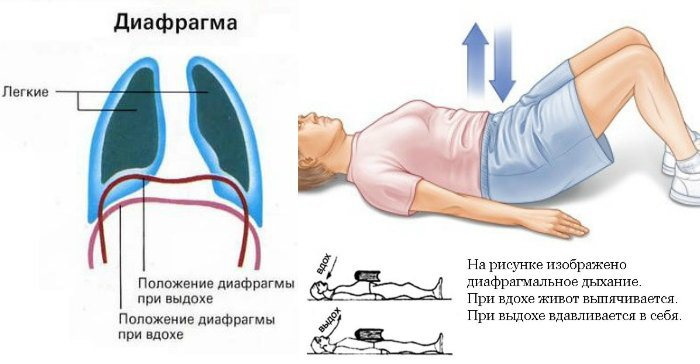 The transfer of the main respiratory load to the muscles of the abdominal cavity allows to reduce the physiological stress on the muscles of the larynx, to achieve a relaxation effect.
The transfer of the main respiratory load to the muscles of the abdominal cavity allows to reduce the physiological stress on the muscles of the larynx, to achieve a relaxation effect.
Lips and trills of the tongue
Trilling with the lips and tongue allows you to get rid of the clamping of the vocal cords, which are caused by the influence of various factors.
To do this exercise, you must observe the following sequence of actions:
- Take a deep breath.
- Relax the muscles of the larynx and face.
- Exhale air so strongly that the upper and lower lips vibrate, creating a characteristic trill sound.
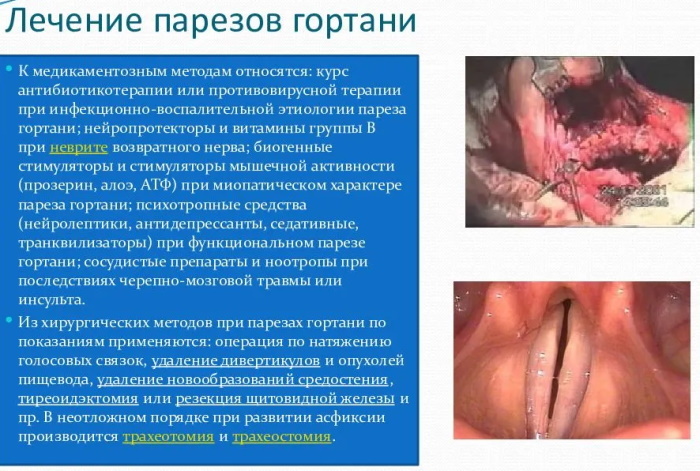 To complicate this exercise, the tip of the tongue protrudes between the lips. The main goal of this workout is to keep the trill sounding for the maximum amount of time. This exercise can be done daily.
To complicate this exercise, the tip of the tongue protrudes between the lips. The main goal of this workout is to keep the trill sounding for the maximum amount of time. This exercise can be done daily.
Surgery
Surgical operation is indicated for patients diagnosed with bilateral complete vocal cord paralysis. It is a medical emergency with upper respiratory tract spasm. If the patient does not carry out the operation in a timely manner, then there is a high probability of death caused by suffocation.
Surgical treatment is also indicated for patients with tumor neoplasms and other tissue pathologies, as a result which is squeezing the vagus nerve and other peripheral nerve endings responsible for the innervation of the vocal ligaments.
Surgical operation to eliminate paralysis of the vocal cords is performed as follows:
- The patient is brought to the sterile conditions of the operating room.
- The patient receives general anesthesia, which is administered by an anesthesiologist. The type of drug and dosage regimen are determined on an individual basis, depending on age, body weight, the presence or absence of concomitant diseases of the body.
- The surgeon performs a dissection of the epithelial tissue of the neck, providing open access to the tumor.
- With the help of a scalpel, the doctor excises an extraneous neoplasm, eliminating pathological pressure on the peripheral nerves of the vocal cords.
- Measures are being taken to prevent acute blood loss caused by surgical tissue damage.
- The stability of the patient's vital signs is assessed.
- The surgeon performs suturing of the injured neck tissue.
Upon completion of the surgical operation, the patient is transferred to the intensive care unit for 24 hours. These precautions are aimed at preventing postoperative complications. If, after the action of anesthesia, the patient's condition is satisfactory, then he is transferred to the hospital of the surgical department, where he undergoes further treatment.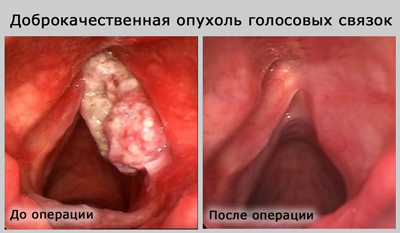
Surgery to remove a tumor can be performed on patients with benign and malignant neoplasms. The operability of a specific clinical case is assessed individually by the attending surgeon.
Postoperative outcomes
The prognosis of the postoperative outcome directly depends on the age of the pathological process. The sooner treatment for vocal cord paralysis begins, the more chances there are for full restoration of their functions with minimal risk of complications. Surgical operation can completely restore the previous sound of the voice, or provide a minor improvement in its functions.
In medical practice, there are occasional cases when a timely performed surgical intervention makes it possible to achieve partial elimination of paresis. His previous voice returns to the patient, but throughout the rest of his life signs of his hoarseness persist, there is hoarseness.
Voice therapy after surgery
Postoperative voice therapy begins no earlier than 1-2 months later. after the completion of surgical treatment. In this case, the methods of therapeutic gymnastics are used, the exercises of which were described in the sections above.
For faster healing of the operated tissues, as well as to eliminate the signs of paresis, the patient may be prescribed additional methods of treatment, namely:
- taking antispasmodic and vasodilating drugs that prevent re-spasm of smooth muscles (Drotaverine hydrochloride, Papaverine, Spazmalgon);
- therapy with B vitamins, which improve the functions of the central and peripheral nervous system;
- the introduction of hormonal drugs that help eliminate edema of the vagus nerve;
- relief of foci of the inflammatory process that arise under the influence of a bacterial or viral infection.
Patients who have previously been diagnosed with neurological disorders are prescribed a course of neurotropic substances. Drugs in this category improve the conduction of neural impulses from the centers of the brain to the nerve endings of the peripheral type.
Paresis of the vocal cords is a pathological condition of the smooth muscles of the larynx that occurs under exposure to chronic inflammation, damage to the structure of the vagus nerve, chronic thyroid diseases glands. Paralysis of this part of the throat is accompanied by complete or partial loss of voice, a feeling of a coma, and suffocation.
The most dangerous is the acute form of bilateral paresis, since the patient may die due to spasm of the upper respiratory tract. Treatment for paresis of the vocal cords depends on the reasons that caused the disease. They use the techniques of voice gymnastics, take antispasmodics, and carry out therapy for concomitant diseases of the body.
Video about paresis of the larynx
Unilateral paralysis of the larynx:

